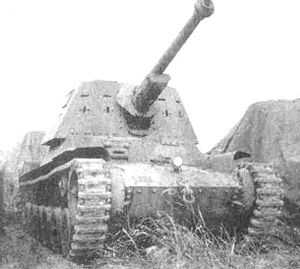Type 3 Ho-Ni III
| Type 3 Ho-Ni III | |
|---|---|
|
Type III Ho-Ni III tank destroyer | |
| Place of origin |
|
| Specifications | |
| Weight | 17 tons |
| Length | 5.52 m (18 ft 1 in) |
| Width | 2.29 m (7 ft 6 in) |
| Height | 2.39 m (7 ft 10 in) |
| Crew | 5 |
|
| |
| Armor | 12-25 mm |
Main armament | 75 mm Type 3 Gun |
Secondary armament | - |
| Engine |
Mitsubishi air-cooled V12 Diesel 170 hp |
| Power/weight | 10 hp/ton |
| Suspension | bell crank |
Operational range | 200 km |
| Speed | 38 km/h |
The Type 3 Gun tank Ho-Ni III (三式砲戦車 ホニIII San-shiki hōsensha) gun tank was a tank destroyer and self-propelled artillery of Imperial Japanese Army in World War II. The Type 3 No-Ni II superseded the Type 1 Ho-Ni I in production, and gave better protection to the crew due to having a completely enclosed superstructure.[1]
History and development
Previous gun tanks, Type 1 Ho-Ni I and Type 2 Ho-I, were not really optimized designs. Ho-Ni I used a semi-enclosed casemate for the main gun, which made the crew vulnerable to the close combat situations expected for a tank destroyer design; Ho-I, despite its enclosed rotating turret, was armed with a low-velocity howitzer more suitable against gun batteries and fortifications and required specialized shaped-charge warhead ammunition in tank destroyer roles. The fully enclosed and armored casemate of the Type 3 Ho-Ni III was intended to address these issues, and an order was placed with Hitachi Ltd in early 1944. Production was hampered by material shortages, and by the bombing of Japan in World War II, and only 31 or 41 units were completed by the time of the end of the war.[2]
Design
The Type 3 Ho-Ni III utilized the chassis of the earlier Type 97 Chi-Ha medium tank.
The main armament of the Type 3 Ho-Ni III was a 75 mm Type 90 Field Gun, loosely based on the French Schneider et Cie Canon de 85 mle 1927.[3][4] The Type 90 also formed the basis for the Type 3 75 mm Tank Gun used in the Type 3 Chi-Nu medium tank.[5] The Type 3 Ho-Ni III 75 mm main gun was mounted in a fully enclosed fighting compartment with its flanks protruding beyond the hull sides, giving the appearance of a gun turret although it is in reality incapable of rotation. There was no provision for secondary armament.[6]
Combat record
Although the Type 3 Ho-Ni III were assigned to various combat units, most were stationed within the Japanese home islands to defend against the projected Allied Invasion. As the surrender of Japan occurred before that invasion, there is no record of the Type 3 Ho-Ni III ever being used in actual combat.
References
- ↑ http://www.irvania.com/downloads/TBOTJapan.pdf
- ↑ History of War.org
- ↑ Tomczyk, Andrzej. Japanese Armor Vol. 4, AJ Press, 2005, p. 3. ISBN 83-7237-167-9
- ↑ Mayer, S. L. The Rise and Fall of Imperial Japan, pp. 57-59
- ↑ Tomczyk, Andrzej. Japanese Armor Vol. 4, p. 3
- ↑ Zaloga, Steven J. Japanese Tanks 1939-45, Osprey Books, 2007. ISBN 9781846030918
External links
- Photos at Taki
- Specifications at OnWar
- History of War.org
- Blueprint of Type 3 Ho-Ni III
- Drawing of Ho-Ni III
Notes
| ||||||||||||||||||||||||||||||
